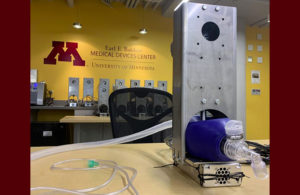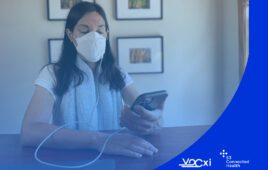Amid the shortages of vital equipment during the COVID-19 pandemic, ventilators stand out — their presence a matter of life or death for people needing respiratory assistance.

Boston Scientific will act as the sole manufacturer of the Coventor. [Image courtesy of University of Minnesota]
“If a patient goes to a hospital, and all of the ventilators are taken up, the only other option the patient has is to have a nurse or, God forbid, a loved one, actually ventilate that patient by hand,” University of Minnesota Earl Bakken Medical Center lab supervisor Aaron Tucker told the DeviceTalks Weekly Podcast.
Tucker, in collaboration with the University of Minnesota’s Dr. Stephen Richardson and an interdisciplinary university team, developed the Coventor as an alternative to the common intensive care unit ventilator. The device, touted as a design costing just $150, became the first of its kind to garner FDA emergency use authorization (EUA).
Boston Scientific (NYSE:BSX) is acting as the sole manufacturer of the device, which the company expects to sell at-cost at approximately $1,000 per unit.
The Minnesota researchers created what they call a “one-armed robot” to replace the potential person who would have to ventilate by hand, freeing up nurses and preventing loved ones from having to perform the ventilation themselves. The device features a bag valve mask (commonly known as an Ambu-bag) and does not require pressurized oxygen or air supply, unlike commercially available ventilators.
The Coventor’s mechanical actuator was designed to stabilize and compress a commercially available ambulatory ventilation bag filled with oxygen or ambient air if oxygen is unavailable. That bag is connected to the patient’s endotracheal tube. It is possible to produce the device’s frame using metal stamping, 3D printing or by modifying consumer goods, according to the Coventor website.
“We are not trying to replace the high-end ventilators,” Tucker said. “We’re in such a unique time right now that we didn’t think they could build those high-end ventilators fast enough. … We wanted to give another option in the case of dire need.”
Tucker and the Minnesota team aren’t the only researchers putting together these kinds of machines. Georgia Tech Woodruff School of Mechanical Engineering associate professor Shannon Yee and a global group contributed to designing a device at Cranfield University in the United Kingdom before building and testing it at Georgia Tech, in collaboration with Emory University.
The collaboration’s mechanical-assist product includes two Ambu-bags to offer the capability to ventilate two patients at once with individual controls for each patient’s volume. The device doesn’t rely on a microprocessor or sensors and instead uses a mechanical design with an eye on scaling more rapidly.
Yee told Medical Design & Outsourcing that he estimates that the bill of materials for just the parts comes in at less than $100, with the most expensive component being the motor and gearbox system at $63 when bought off the shelf.
Including labor, Yee said they’re looking at a couple hundred dollars as the cost to make the machines. In the pilot assembly line, the team assembled seven devices in two hours, giving Yee confidence in the ability to scale production.
“I wouldn’t classify it as home-built,” Yee said. “What we specifically targeted in our design was recognizing that we’re going to be facing a logistics and supply chain problem. We wanted our design to be simple enough so that conventional manufacturing techniques … could be employed in order to mass-produce these makeshift ventilators.”
Like the Minnesota researchers’ device, this design is targeting the option to ventilate patients without replacing the common ICU machines. Clinicians offered positive feedback on the device and the next steps include pursuing FDA EUA after licensing the product to a manufacturer.
Will we know if they’re helping or hurting?
Device Events founder & CEO Madris Tomes, who previously worked in the FDA’s post-market surveillance division, raised concerns over the agency’s relaxed guidance on reporting problems with devices so device makers can focus on getting supplies out.
Tomes pointed out that that problems could arise with certain data not being reported to the FDA, meaning word of mouth may not be enough to prevent the use of potentially problematic devices.
“With the relaxed rules, we’re not going to get that data,” Tomes told MDO. “It’s not a place where the FDA should be relaxing.”
However, if products like the Coventor prove safe and effective enough for FDA authorization, and more efforts like the product Yee’s team developed reach the market as well, the potential to plug a massive hole in the shortage of ventilators excites the former FDA employee.
“It’s amazing that they’re coming up with different ways to help these patients,” Tomes said. “To have a second option, even if it’s not as sophisticated … It’s fantastic that people all around the world are trying to help solve this problem.”





I think the title of this piece (How are alternative ventilators helping during the COVID-19 pandemic?) is misleading. It reads in the present tense, as though alternative ventilators have been deployed and are helping. That’s clearly not the case. To the best of my knowledge, there are no alternative ventilators that have been placed in use in the US. I am put off by the suggestion that these alternative ventilators are poised to come to the rescue when in fact that’s not happening, nor is it likely to happen. I know it’s nice for everyone who is patching together an alternative ventilator to see their name and picture in print during this crisis, but how about a more honest article about the issues that have to be overcome to get FDA clearance and whether or not the alternative ventilators meet the needs of the clinicians who would actually operate them on patients. Thanks.